When Comet Siding Spring skimmed just 84,500 miles from Mars last month, NASA’s Opportunity and Curiosity Rovers – along with several orbiting Mars spacecraft – readied their cameras to record the historic flyby. Opportunity’s photos revealed a small, fuzzy blob against the stars of Cetus the Whale, but most of us searched in vain to find any trace of the comet among the blizzard of noise in pictures snapped by Curiosity. Yet it may be there after all.
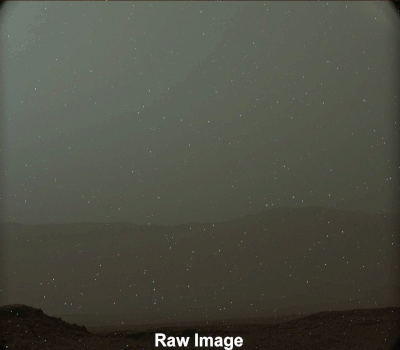
In this panoramic image at top, assembled and processed by James Sorenson to remove the pervasive noise in the original photos, we see with a twilit landscape just after sundown. Look closely in the upper left hand corner and you’ll see a speck of light. That’s it! Combined with positional information, Sorenson tentatively identified that pixel as Comet C/2013 A1 Siding Spring. OK, it’s not much to look at but may be our best candidate for the hoped-for photo from Curiosity.
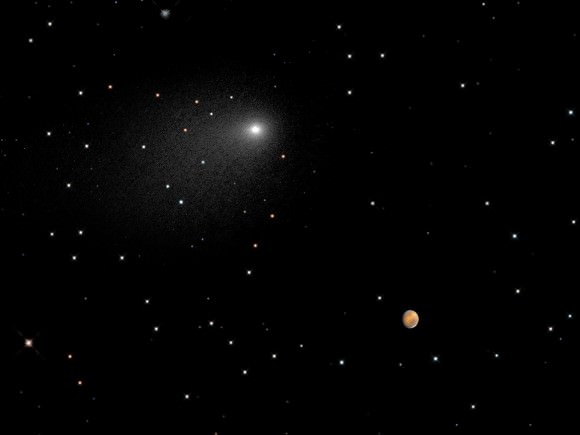
Remember that conditions were far from ideal when the picture was taken. There was considerable dust and haze in the Martian atmosphere over Gale Crater. Dust effectively absorbs and also scatters light. The bright twilight sky only made the comet more difficult to discern. If you’ve ever struggled to see Mercury at dusk on a hazy summer evening, you’ll understand what our robot was up against.
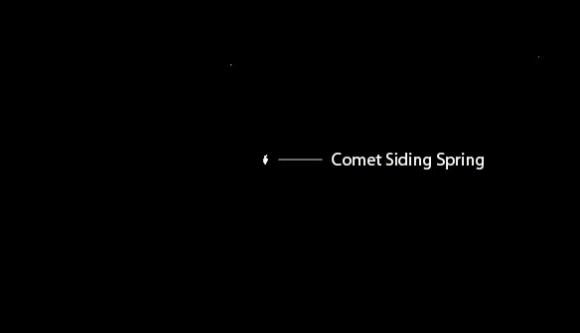
The European Space Agency’s Mars Express orbiter also chimed in with a recent set of comet images. As it flew by, Siding Spring was traveling at around 35 miles per second (56 km/sec) relative to Mars. Images were acquired at 17-second intervals at a resolution of 10.5 miles (17 km) per pixel. What do they show? The irregular shape might make you might think you’re seeing the actual shape of the comet’s nucleus. Unfortunately, that’s impossible because it’s less than a kilometer across and each pixel in the photo spans 17 km. Instead, we’re seeing the combined light of the nucleus and extended coma, the surrounding cloud of gas and dust. Why the images are pure black and white with no grey tones is unclear.
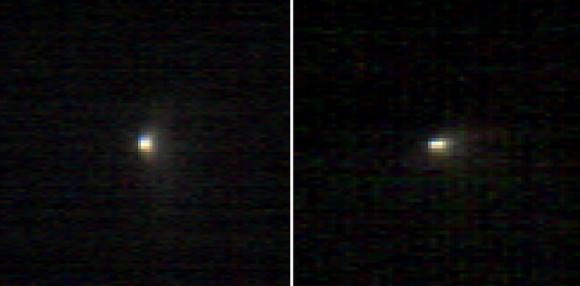
Besides the the close-up photo taken with the HiRISE camera on NASA’s Mars Reconnaissance Orbiter, its Compact Reconnaissance Imaging Spectrometer for Mars (CRISM) got busy photographing the dusty inner coma generated when sunlight warms and vaporizes dust-laden ice in the nucleus. The scale of the left image is approximately 2.5 miles (4 km) per pixel; for the right image, it is about 3 miles (5 km) per pixel.
According to NASA, CRISM observed 107 different wavelengths of light in each pixel. Here, only three colors are shown. Researchers think the appearance of color variations in the inner coma could be due to the properties of the comet’s dust, possibly dust grain size or composition. More photos and results from all the spacecraft will appear in the weeks and months ahead as scientists continue their analyses.
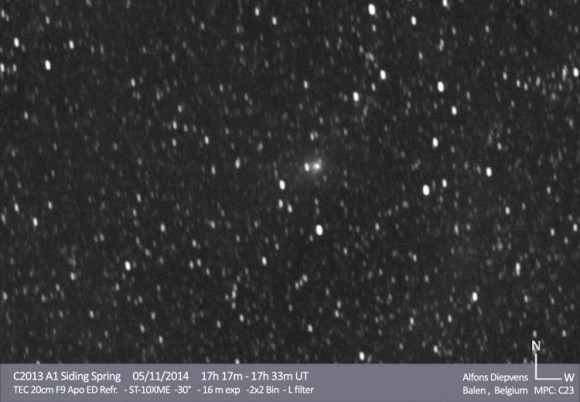
Comet Siding Spring has left Mars and its crew of robotic eyes behind as it crawls north into the constellation Serpens low in the southwest at dusk. Amateur astronomers are still keen to photograph it at every opportunity. Recent observations indicate a temporary re-brightening, though the comet remains a dim 11th magnitude object.


Not much to look at, but still better than nothing. Here’s hoping there’s more data in the future releases AND Mr. Sol co-operates with a timely CME to light things up a bit?
Aqua4U,
We’ll find out more during the NASA teleconference tomorrow on spacecraft observations of Siding Spring. Yours truly will attend.
That’s the first time I’ve had to use averted vision to see something on my monitor!
And I thought that:
a) I need new glasses
b) I’m getting “old” (although “they” say that vision is usually the second thing to go)
c) All three
😉
Thank you Bob
Pete,
That’s pretty funny … and true!
My short movie few minutes before close approach available on YouTube: https://www.youtube.com/watch?v=NvHXMzMdqMQ